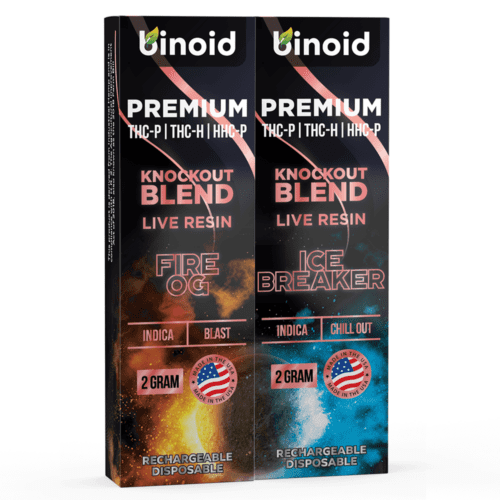
How Is the Percentage of Indica to Sativa Weed Strains Determined?
We spend a lot of time at Binoid talking about strains, because the specific strain you select when purchasing a cannabinoid product can have a profound influence on the effects that you feel. Most people find that they have a specific preference when it comes to indicas, hybrids or sativas, because they’re seeking out something in particular, whether that be the perfect mellowing strain for bedtime, or a heavily uplifting, creative effect from a sativa.
Hybrids are undoubtedly the popular category these days, thanks to revolutionary breeding methods that allow breeders to cross strains like never before to create very specific cultivars that address particular needs. We see 50/50 hybrids, indica-leaning hybrids and sativa-leaning hybrids everywhere, but what actually determines the ratio of indica to sativa, and how much does it matter when it comes to making the right choice for your needs?
TO BUY THC PRODUCTS CLICK HERE
Sativa vs. Indica: What’s the Difference?
Most people distinguish between indica and sativa strains based on their appearance and terpene profile.
- Sativa strains are known for growing tall and lanky, with very dense flower buds.
- Indica strains, meanwhile, grow relatively short and bushy, with wispier flower buds.
So, you can identify the type of cultivar by sight alone. But, if you were to get more technical, you’d look at the terpene profile, since a rule of thumb is that any strain with more than 0.5% myrcene in it is an indica. Myrcene is a terpene known for its drowsy, calming effects, so now you can understand its relationship to indica cultivars.
Hybrid Strains: A Category That’s Growing by the Minute
Indicas and sativas are wonderful and all, but more and more people are seeking out hybrid strains. Hybrid strains are a cross between an indica and a sativa, bred selectively by a cannabis breeder. Hybrid strains are great because of two reasons.
- They offer a nice balance between indica and sativa effects.
- Today’s breeders use high-tech methods to deliberately create hybrid cultivars that can best address specific needs, such as strains for anxiety relief, strains for sleep, strains for boosting creativity and so on.
Hybrid strains are not always 50/50 indica to sativa. In fact, in most cases, the ratio is not perfectly balanced. You can find anything from 90/10 to 50/50, either in the form of an indica-leaning or sativa-leaning hybrid. Naturally, the closer a hybrid’s ratio is to 100% one way or another, the more likely it is that its effects will resemble that of a true indica or sativa. Examples are Presidential Kush, a 90/10 indica to sativa hybrid, and Sour Diesel, a 90/10 sativa to indica hybrid.
What Makes a Hybrid More Sativa or Indica-Leaning?
When shopping for a hybrid, it goes without saying that you should look at the ratio of indica to sativa since this will dramatically alter the effects that you feel. But, what actually gives each hybrid its unique ratio? Well, the answer is quite simple.
Breeding is a practice that’s far more complicated than many realize. Once two strains are bred together through fertilizing a female with a male cannabis plant, an offspring is eventually born. But, as is the case throughout biology, how much of each parent’s DNA ends up in the offspring can vary, seemingly at random. Let’s say you cross a pure indica like Afghani Kush with a pure sativa like Green Crack. One might think you’d end up with a perfect 50/50 offspring, but that’s not the case because genetics rarely act so predictably, just like the child of two parents rarely shows a 50/50 split between both parents’ DNA.
Now, at this point, two things can happen.
- A breeder can keep the offspring, and use chromatographic methods to identify its terpene profile, which then informs them on how much of the offspring is indica, and how much is sativa, by comparing its terpene profile to those of its parents.
- The breeder can create phenotypes, which means crossing the parents over and over again to get different results.
All that being said, it’s worth pointing out that to create a perfect 50/50 hybrid is quite rare. If you do come across one then, you’re looking at quite an impressive genetic feat.
Why the Ratio Isn’t Everything
Now that you have a better understanding of hybrid ratios and what they mean, it’s important to remember that the ratio alone doesn’t necessarily tell you everything there is to know about what to expect. As we’ve made clear, genetics are unpredictable.
Sometimes, you end up with a 70/30 hybrid that carries strong indica-like traits, or an indica-dominant hybrid that has a weak body high. So, always read the full description of a strain before choosing it, because the ratio by itself can only tell you about the genetics of the strain, and less about the very specific nature of the effects.
Indica-Dominant, Sativa-Dominant, and Balanced Hybrids: Different Ratios for Unique Effects
Ultimately, the ratio of a hybrid paints a fascinating picture of biology in action, as the genetics of any given cultivar can vary even if it boasts the same exact parents. Using this information, you can have a clearer understanding of what each hybrid strain can offer, and what it means.
At Binoid, we offer a dazzling variety of hybrid strains in all kinds of cannabinoid products, including 50/50 hybrids, indica-leaning hybrids, and sativa-leaning hybrids. This way, you can find the perfect balance of effects for you.
TO BUY THC PRODUCTS CLICK HERE
-
Product on sale
 THCA Vape Cartridges – Bundle$177.99
THCA Vape Cartridges – Bundle$177.99$203.99





